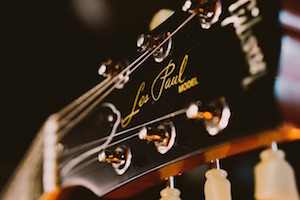Among the most frequent questions that newcomers to the instrument ask when they’re starting out, are the two following:
- should I learn to play on an electric or acoustic guitar?
- should I really learn to play with an acoustic guitar eventhough I plan on playing an electric guitar in the end?
Choosing the right guitar is crucial in that it will have an influence on how eager you are to practice your new instrument in the first months. Since this period is when most people quit, it is important to be motivated enough to go through obstacles.
There’s many different types of guitars (some of them even are hybrids), but, put simply, there are two main categories:
- acoustic guitars
- electric guitars
The main difference is that acoustic guitars are made of a hollow body that amplifies the sound produced by the strings, whereas electric guitars must be paired with an amplifier.
Acoustic guitars
Acoustic guitars can again be split into two main categories:
- steel-string guitars,
- nylon string guitars.
Steel-string guitars generally have a larger body, made out of bright, yellowish wood. Most importantly, they use steel strings, which produce a sharp, metallic sound. Classical guitars also have three steel strings (the three low strings), but the three highs are made out of nylon, which have a mellow sound. Genres of music played on those two types of guitars include classical music and latin music for classical guitars; rock, pop or blues for steel-string guitars.

Here’s how an acoustic guitar sounds:

Here’s how a classical guitar sounds:
(Please note that there are multiple guitars playing at once in this clip.)
Electric guitars
Electric guitars have a full body that’s paired with an electronic setup made of pickups that are located below the strings in order to capture the signal. They also feature tone and volume knobs. Played on their own, they’re really quiet. A guitar player might be able to hear himself if he plays in a quiet room, but this isn’t the sound anybody is looking for. The sound will have to be amplified, and the amp plays a big role in the final tone.
Sound effects such as reverberation, distortion, chorus, etc. can also be added to an electric guitar’s sound, which allows for great flexibility. Electric guitars can by the way be heard in all genres: rock, pop, funk, metal, jazz, etc.
Electric guitars have thinner strings and necks, and so this is less demanding of a beginner player’s hand. It hurts less. That being said, the various settings that can be tweaked on the instrument and on the amplifier can be very confusing when starting out.

Here’s how an electric guitar sounds:
Final words
At the end of the day, you should mostly think about what genre of music you like the most, and get the kind of guitar that is used to play that music. Then you’ll truly enjoy the process, and difficulties won’t bring you to a halt. If you’re on a budget, an acoustic guitar might be a good choice considering that there’s no amp nor cables to buy on top of the guitar. Good luck!



